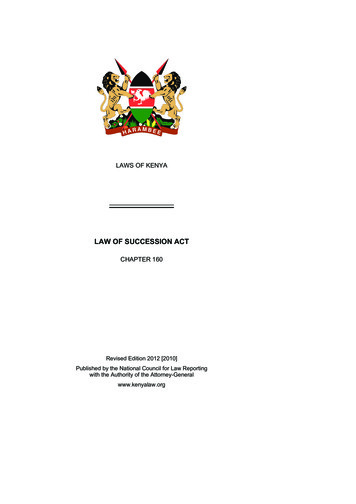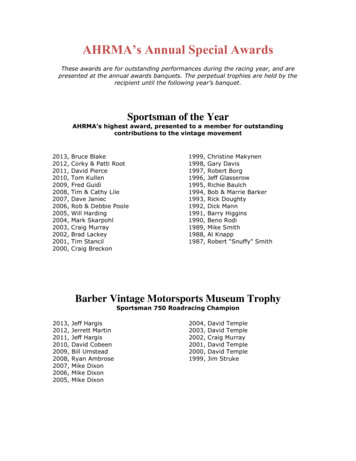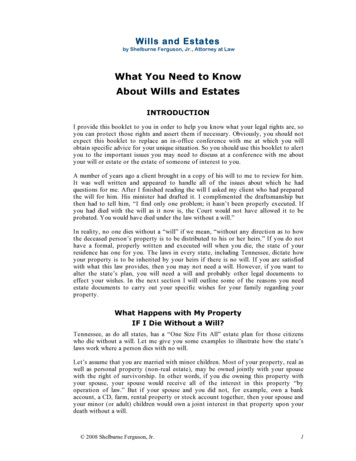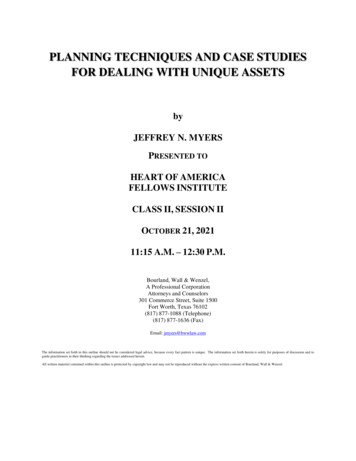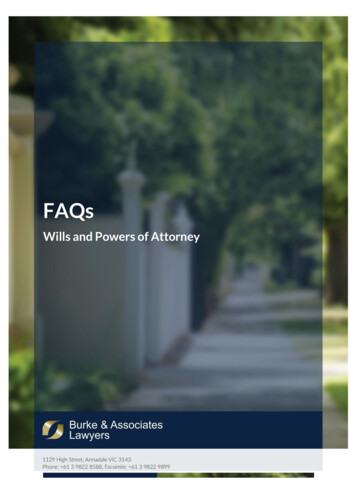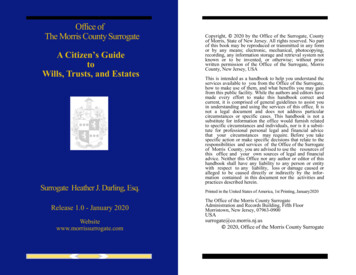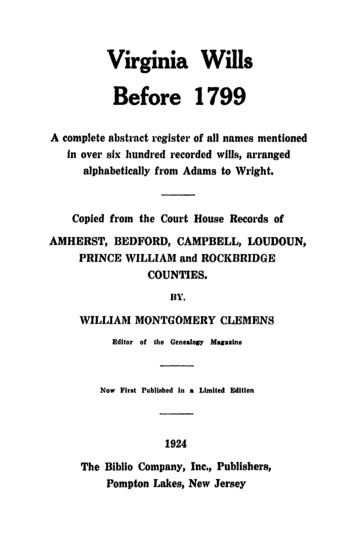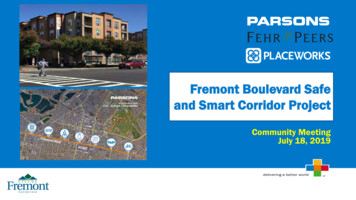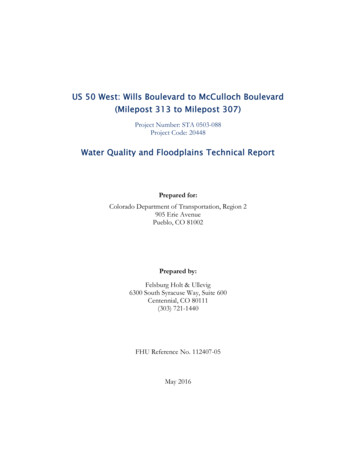
Transcription
US 50 West: Wills Boulevard to McCulloch Boulevard(Milepost 313 to Milepost 307)Project Number: STA 0503-088Project Code: 20448Water Quality and Floodplains Technical ReportPrepared for:Colorado Department of Transportation, Region 2905 Erie AvenuePueblo, CO 81002Prepared by:Felsburg Holt & Ullevig6300 South Syracuse Way, Suite 600Centennial, CO 80111(303) 721-1440FHU Reference No. 112407-05May 2016
Table of ContentsPage1. Introduction . 12. Project Description . 42.1 Proposed Action . 42.2 Action Alternative. 53. Water Quality . 73.1 303(d) List . 74. Issues . 85. Methods . 86. Impact Summary . 97. Mitigation Strategies .118. Floodplains .148.1 Proposed Floodplain Impacts . 168.1.1 Williams Creek . 168.1.2 Wild Horse Dry Creek . 179. Floodplain Mitigation .1910. Agency Coordination .1911. CDOT Coordination .1912. Permits.1913. References .20List of .5.6.Proposed Action and PEL Study Corridor . 3Proposed Action . 6Water Quality Improvements . 10FEMA FIRM . 15Williams Creek Profile Comparison . 17Wild Horse Dry Creek Profile Comparison . 18List of TablesTable 1.Summary Water Quality Facility at Wild Horse Dry Creek . 12i
List of Acronyms and SUS 50WQCVWSEmicrograms per literAvenuebase flood elevationBoulevardbest management practicesconcrete box culvertColorado Department of Public Health and EnvironmentColorado Department of TransportationColorado Discharge Permit SystemConditional Letter of Map Revisionenvironmental assessmentextended detention basinFlood Hazard Area DelineationFelsburg Holt & UllevigFederal Highway AdministrationFlood Insurance Rate MapLetter of Map RevisionMunicipal Separate Storm Sewer SystemPlanning and Environmental LinkagesPueblo West Metropolitan DistrictRoadright-of-waySeleniumStormwater Management Plantotal suspended solidsUnited States Highway 50Water Quality Capture Volumewater surface elevationii
11.Introduction234567891011121314This environmental assessment (EA) is for safety and capacity improvements to US Highway 50(US 50) between Wills Boulevard (Blvd) and McCulloch Blvd that the Colorado Department ofTransportation (CDOT) is proposing, in consultation with Federal Highway Administration(FHWA), within the City of Pueblo, Pueblo County, and Pueblo West Metropolitan District(PWMD). This project is the third in a sequence of improvements that CDOT is making to US 50,all under the framework of the US 50 West Planning and Environmental Linkages (PEL) Study (CDOT,2012a). The US 50 West PEL established the purpose and need, evaluated a full range ofalternatives, and developed the US 50 West PEL Implementation Plan (CDOT, 2012b) for the PELrecommended Preferred Alternative within a 12-mile corridor from Swallows Road to BaltimoreAvenue. Safety and capacity improvements included in the PEL recommended Preferred Alternativegenerally consist of widening US 50 from four lanes to six lanes from McCulloch Blvd to Wills Blvdand establishing grade-separated interchanges at McCulloch Blvd, Purcell Blvd, and Pueblo Blvd. US50 would remain a four-lane highway west of McCulloch Blvd.1516171819At the completion of the PEL Study, funds were not available to construct the recommendedimprovements for the entire PEL Corridor, leading CDOT to implement a sequence ofimprovement projects in coordination with FHWA. The following summarizes the sequence ofcompleted National Environmental Policy Act (NEPA) studies and recent improvements for US 50that have led to this US 50 West Wills Blvd to McCulloch Blvd EA, as shown in Figure 1:2021222324252627 The US 50 West Purcell Blvd to Wills Blvd EA (CDOT, 2014) provides widening 3.4 miles of28293031 The US 50 West Wills Blvd to BNSF Acceleration Lane Categorical Exclusion (CDOT, 2015),323334353637383940 CDOT and FHWA are currently undertaking the US 50 West Wills Blvd to McCulloch Blvd EAeastbound US 50 from two lanes to three lanes from Purcell Blvd to Wills Blvd to establishfive lanes (three eastbound and two westbound). Safety improvements include addingnorthbound right turns onto US 50 at McCulloch Blvd and Purcell Blvd and establishingtwo water quality ponds on the east and west sides of Wild Horse Dry Creek. In addition,widening the eastbound bridge at Wild Horse Dry Creek accommodates a futurepedestrian/bicycle path. Construction of these improvements is scheduled for completion in2016.recently approved by CDOT, establishes a westbound acceleration lane on US 50 from WillsBlvd to the BNSF right-of-way (ROW), east of the BNSF bridge, shown on Figure 1.Construction of the acceleration lane is scheduled for 2016.to provide additional safety and capacity improvements to US 50. Improvements includewidening 3.4 miles of westbound US 50 between Wills Blvd and Purcell Blvd, from twolanes to three lanes; and widening 2.4 miles of westbound and eastbound US 50 betweenPurcell Blvd and McCulloch Blvd, from two lanes to three lanes in each direction. Gradeseparated interchanges would be established within the US 50 ROW at Purcell Blvd andPueblo Blvd. A future pedestrian/bicycle path would also be accommodated between WillsBlvd and Pueblo Blvd. A regional water quality pond is proposed to treat US 50 runoff andPWMD municipal runoff.1
123The Proposed Action, in combination with the improvements under construction from Purcell Blvdto Wills Blvd, would establish six-lane capacity (three lanes in each direction) in the most congestedportion of the PEL Corridor, between Wills Blvd and McCulloch Blvd.456789For this EA, the existing features of US 50, including the improvements approved through theUS 50 West Purcell Blvd to Wills Blvd EA (CDOT, 2014) and the US 50 West Wills Blvd to BNSFAcceleration Lane Categorical Exclusion, represent the No Action Alternative. The No ActionAlternative assumes that no other major capacity improvements would be made to US 50. The NoAction Alternative also includes routine maintenance to keep the existing transportation network ingood operating condition.10111213CDOT and FHWA prepared this EA to evaluate the Proposed Action benefits and environmentalimpacts, relevant to the No Action Alternative. This EA will also ensure that the Proposed Actionwould have logical termini and independent utility and would not restrict other reasonablyforeseeable transportation improvements identified in the PEL recommended Preferred Alternative.1415Future elements of the PEL recommended Preferred Alternative will undergo NEPA analysis asfunding for design, ROW, and construction becomes available.1617A water quality and floodplain assessment was conducted for the US 50 West Project in support ofthe EA. This technical report:18 describes the water quality and floodplains of creeks within and adjacent to the project area, evaluates the potential for impacts as a result of the Proposed Action and No Action192021Alternative, and identifies proposed mitigation measures.2
Figure 1.Proposed Action and PEL Study Corridor3
12.Project Description22.1Proposed Action34567891011The Proposed Action for this US 50 West Wills Blvd to McCulloch Blvd EA involves widening 3.4 milesof westbound US 50 from two lanes to three lanes, to include a third westbound lane from WillsBlvd (Milepost 313.15) to Purcell Blvd (Milepost 309.78), and widening 2.4 miles of both westboundand eastbound US 50 from Purcell Blvd (Milepost 309.78) to McCulloch Blvd (Milepost 307.34).Grade-separated interchanges would be established at Pueblo Blvd and at Purcell Blvd. TheProposed Action from Wills Blvd to McCulloch Blvd, in combination with the eastboundimprovements under construction from Purcell Blvd to Wills Blvd, would six-lane capacity (threelanes in each direction), for 5.8 miles of US 50, consistent with the US 50 West PEL ImplementationPlan (CDOT, 2012b).1213CDOT is proposing the following transportation improvements between Wills Blvd and McCullochBlvd:1415161718 Wills Blvd Intersection to BNSF Railroad Bridge (Milepost 313.15 to Milepost 312.87)19202122232425262728293031323334 BNSF Railroad Bridge through Pueblo Blvd Intersection (Milepost 312.87 to3536373839 Pueblo Blvd to Purcell Blvd Intersection (Milepost 312.65 to Milepost 309.78) – The– A third westbound lane would be established by restriping the Wills Blvd to BNSFacceleration lane (US 50 West Wills Blvd to BNSF Acceleration Lane Categorical Exclusion;CDOT, 2015) and by extending the westbound lane through the BNSF railroad bridgeunderpass to Pueblo Blvd.Milepost 312.65) – The westbound lanes of US 50 in the vicinity of Pueblo Blvd would berealigned to be parallel to the eastbound lanes from Milepost 311.45 to Milepost 312.65, andthe existing westbound bridge over Wild Horse Dry Creek would be replaced. A gradeseparated interchange would be established, with Pueblo Blvd crossing over US 50. TheWilliams Creek concrete box culvert (CBC) under the eastbound US 50 lanes would beextended 160 ft. to accommodate the realigned westbound lanes, including the westboundthird-lane widening. Pueblo Blvd would be widened to accommodate two additional left turnlanes onto westbound US 50 via a right-side exit ramp. The existing westbound US 50 laneswould be retained and modified to provide access from US 50 onto southbound PuebloBlvd. The US 50 West PEL Implementation Plan (CDOT, 2012b) identifies the ProposedAction at US 50 at Pueblo Blvd to be implemented as phased improvements over time. TheProposed Action would implement a diamond-type interchange at Pueblo Blvd. The PELrecommends a Diverging Diamond Interchange configuration, which would be implementedat some time in the future when the Pueblo Blvd Extension is developed as an expresswaybetween US 50 and I-25 (CDOT, 2012a).westbound third lane would extend from Pueblo Blvd to Purcell Blvd, and a full six-lanegrade-separated interchange would be developed, with US 50 crossing over Purcell Blvd. ACBC under Purcell Blvd would be extended to accommodate a future pedestrian/bicycletrail and future widening of Purcell Blvd.4
1234567 Purcell Blvd to McCulloch Blvd (Milepost 309.78 to Milepost 307.34) – The ProposedAction would include a third westbound lane extending from Purcell Blvd and terminating ata right turn onto northbound McCulloch Blvd; and a third eastbound lane extending fromthe newly established northbound right turn from McCulloch Blvd and terminating atPurcell Blvd. The ultimate configuration for US 50 and McCulloch Blvd, although not partof this EA, is a grade-separated interchange as identified in the US 50 West PELImplementation Plan (CDOT, 2012b).89101112 Pedestrian/Bicycle Path – The Proposed Action would accommodate a future1314151617181920 Municipal Separate Storm Sewer System (MS4) Improvements/Regional Pond – Thepedestrian/bicycle path within CDOT ROW along the south side of US 50 from Wills Blvdto Pueblo Blvd, which is an element of the PEL recommended Preferred Alternative(CDOT, 2012a). The slope paving adjacent to the eastbound lanes at the BNSF railroadunderpass would be modified to accommodate the pedestrian/bicycle path.Proposed Action would include water quality improvements and a regional pond.Stormwater runoff for the westbound lane widening and interchange improvements betweenWills Blvd and the Pueblo Blvd (Milepost 313.15 to Milepost 311.5) would be directed to thetwo extended detention basins (EDBs) under construction on the east and west sides ofWild Horse Dry Creek. Stormwater runoff for the westbound and eastbound lanes betweenPueblo Blvd and McCulloch Blvd (Milepost 311.5 to Milepost 307.34) would be directed to aproposed regional pond site west within a private parcel of Pueblo Blvd and south of US 50.21Figure 2 provides a general map of the Proposed Action.222.2232425262728The existing features of US 50, including the improvements approved through the US 50 West PurcellBlvd to Wills Blvd EA (CDOT, 2014) and the US 50 West Wills Blvd to BNSF Acceleration LaneCategorical Exclusion, represent the No Action Alternative. The No Action Alternative assumes thatno other major capacity improvements would be made to US 50. The No Action Alternative alsoincludes routine maintenance to keep the existing transportation network in good operatingcondition.Action Alternative295
Figure 2.Proposed Action6
13.Water Quality2345The receiving water bodies of interest include Wild Horse Dry Creek and Williams Creek. WilliamsCreek flows into Wild Horse Dry Creek about 1-mile south of US 50, and Wild Horse Dry Creekflows into the Arkansas River 4 miles to the south. Wild Horse Dry Creek crosses US 50 atMilepost 312.558, and Williams Creek crosses at Milepost 312.500.6789The water bodies’ listed beneficial use according to the Colorado Department of Public Health andEnvironment (CDPHE) Regulation 32 is a user protected designation and an aquatic life warm 2,recreation E and agriculture. Impairment levels are E. coli at 126 colony forming units/100 milliliterand selenium (Se [ac]) at 708 micrograms per liter (µg/L).103.1303(d) List11121314The CDPHE Water Quality Control Division (Division) 303(d) list for impaired waters includesWild Horse Dry Creek. The CDPHE water body identity for Wild Horse Dry Creek isCOARMA04a (Segment 4a). The entire creek has a 303(d) high priority listing for E. coli and a lowpriority for selenium (Se). Williams Creek is COARMA04a (Segment 4d) and is not impaired.15161718Regulation 32 for final action provides updated “Wildhorse Creek” information effectiveDecember 31, 2013, regarding the designation and the selenium standards (which are the seleniumambient quality-based site-specific standards proposed by the PWMD during the June 2013rulemaking hearing):192021222324 On page 22 is the Middle Arkansas Segment 4a, “Mainstem of Wildhorse Creek from the25262728 On page 11 is the 32.6(4) Assessment Criteria, “The following criteria shall be used when293031 On pages 63 and 64 is the Statement of Basis and Purpose language for the Mainstem ofsource to the confluence with the Arkansas River,” for which the Designation is UseProtected (UP) and the selenium (Se) water quality standards are Se(ac) 2376 µg/L andSe(ch) 2110 µg/L. Under “Temporary Modifications and Qualifiers,” there is a note: “Seeassessment location at 32.6(4).” Numeric standards for other water quality parameters arelisted on page 22 for Middle Arkansas Segment 4a.assessing whether a specified waterbody is in attainment of the specified standard. (a) MiddleArkansas Segment 4a, Wildhorse Creek, Se(ac) 2376, Se(ch) 2110: Selenium AssessmentLocation, Wildhorse Creek above Pesthouse Gulch: 38.296478, -104.649201”Wildhorse Creek (Middle Arkansas Segment 4a) regarding the Water Quality ControlCommission’s revision of the selenium ambient quality-based site-specific standards.327
12Regulation 32 for final action also provides “Williams Creek” information regarding the designationand the selenium standard:345678 On page 22 is the Middle Arkansas Segment 4d “All tributaries, including wetlands, to the91011121314151617The source of selenium is suspected to be related to natural background conditions from shaleoutcrops within the watershed. Selenium and E. coli are not associated with highway operations andare not considered to be an environmental issue for this project. Nevertheless, this roadway projectwill provide treatment for roadway runoff that extends above and beyond the minimumrequirements of providing the water quality capture volume (WQCV) for the added pavement areas.These additional treatments will include additional WQCV for existing tributary pavement andproviding flat swales adjacent to the road shoulders to allow sediment to settle out. Other waterquality improvements not currently provided will include adding riprap erosion protection at culvertends and around bridge abutments and piers.184.1920212223Potential construction phase issues include sediment or pollutants running off exposed areas orpaved areas and entering a waterway, tributary culverts and swales, or private property.Post-construction issues include pollutants being washed off paved surfaces and eventually enteringwaterways or adjacent properties. Increased pavement will also increase the amount of surfacerunoff.245.2526272829303132Based on CDOT’s Water Quality Model Program Decision Tree and Evaluation Handbook (February 2013),it was determined that no modeling was necessary for this project. Data uses included checking theCDPHE 303(d) list of impaired waters database. The 303(d) lists Wild Horse Dry Creek as having ahigh priority for E. coli and a low priority for selenium (Se), neither of which are pollutantsassociated with transportation projects or pavement. The proposed permanent water quality facilitiesidentified in the Proposed Action include flat swales adjacent to the roadway and two EDB waterquality ponds. The swales and EDBs will attenuate flows, allow infiltration and evapo-transpiration,and treat biological uptake. This technical report involved no sampling or analysis.Arkansas River and Pueblo Reservoir from the inlet to Pueblo Reservoir to the ColoradoCanal headgate, except for specific listings in the Fountain Creek Subbasin and insegments 4a, 4b, 4c and 4e through 18b,” for which the Designation is Use Protected (UP)and the selenium (Se) water quality standard is Se(ch) 20(Trec). Numeric standards forother water quality parameters are listed on page 22 for Middle Arkansas Segment 4d.IssuesMethods8
16.Impact Summary2345Permanent impacts on water quality in Wild Horse Dry Creek and Williams Creek will be mitigatedwith a combination of project improvements, including improved flat native grass lined swalesadjacent to the roadway, use of two EDB Ponds A and B under construction at Wild Horse DryCreek, and development of a regional Pond C, as shown on Figure 3.67891011121314 Wills Blvd and Pueblo Blvd (Milepost 313.15 to Milepost 311.5) – Stormwater runoff for15161718192021 Pueblo Blvd and McCulloch Blvd (Milepost 311.5 to Milepost 307) – Stormwater2223242526272829the westbound acceleration lane, third westbound lane widening, and interchangeimprovements between Wills Blvd and Pueblo Blvd will be directed to the EDBs underconstruction on the east side (Pond A) and west side (Pond B) of Wild Horse Dry Creek.For the urban section of US 50 from Wills Blvd to BNSF (Milepost 313.15 toMilepost 312.87), water quality improvements include curb and gutter and stormwater pipeand inlets that will connect with the recently installed stormwater pipe on the south side ofUS 50. Flows will be carried to Pond A on the east side of Wild Horse Dry Creek(US 50 West Wills Blvd to BNSF Acceleration Lane Categorical Exclusion (CDOT, 2015).runoff for the proposed westbound lane between Pueblo Blvd and Purcell Blvd, and theproposed westbound and eastbound lanes between Purcell Blvd and McCulloch Blvd will bedirected to a proposed regional pond site (Pond C) west of Pueblo Blvd through a system offlat native grass lined swales adjacent to US 50. Cross culvert drainage pipes under US 50will connect proposed eastbound and westbound swales. Appendix A provides additionaldetail about the regional pond.These modifications will treat new pavement plus existing pavement. Currently, there is no waterquality treatment for the roadway runoff. This project, in combination with the US 50 eastboundimprovements, will improve the water quality of stormwater runoff. Temporary constructionimpacts will include working adjacent to drainageways. Impacts on drainageways can occur duringbridge construction, storm drainage construction, removal of invasive plant species (tamarisk andnoxious weeds), or grading operations. It is planned to have construction best management practices(BMPs) adjacent to drainageway areas to prevent erosion in adjacent construction zones anddeposition of sediment.9
1Figure 3.Water Quality Improvements2310
17.Mitigation Strategies234567The following are preliminary strategies for mitigation of impacts and are subject to change. TheNational Environmental Policy Act decision document will define final mitigation measures. Theproject will closely follow the existing horizontal and vertical alignment of eastbound US 50 tominimize impacts. The new bridge at Wild Horse Dry Creek will be of similar length and location,and grading below the bridge is planned to minimize impacts to the waters of the US and avoidwetlands.8910111213141516171819The two water quality ponds currently under construction will pass treated stormwaters to WildHorse Dry Creek via culverts, with end sections and riprap erosion protection. The proposedregional pond will pass treated stormwaters to a tributary of Wild Horse Dry Creek via a pipelinewith end sections and riprap erosion protection. A preliminary bridge hydraulics analysis for US 50over Wild Horse Dry Creek was performed. Results indicate that the proposed bridge, with minorchannel improvements, will produce a minor-rise in the 100-year regulatory base flood elevation(BFE). During construction, impacts will be minimized. Final design plans will include a detailedStormwater Management Plan (SWMP) and a set of erosion and sediment control plans. This set ofplans will guide the contractor and CDOT construction management forces during construction. Itwill be a living document that can be modified or revised in the field during construction to addressany unforeseen erosion or sedimentation problems. BMPs anticipated to be used for this projectmay include: Sweeping with a pick-up broomErosion logsAggregate bagsCheck damsSilt fenceConcrete washout structuresStorm drain inlet protectionStabilized construction entrances Removal and disposal of sedimentTemporary bermsNative seeding and mulchingPlacement of soil retention blanketsPlacement of plastic fence to protect sensitive areasNo debris from demolition (bridges, etc.) allowedin waterways Use of clean water diversions during stream work20212223An erosion control supervisor will be present at the construction site to ensure that erosion controlis provided throughout the construction period and that the SWMP is implemented. Erosion controldevices will be added, repaired, modified, and maintained as required to limit erosion andsedimentation within the project site.24252627CDOT’s MS4 requires either 100 percent WQCV or 80 percent total suspended solids (TSS)removal for new impervious areas in a project area. The permanent water quality facilities for thisproject will provide 100 percent WQCV for the new paved areas within the project area. Thisconforms to CDOT’s MS4 requirements.28293031The mitigation strategy for permanent water quality includes three EDBs: (1) Pond A (underconstruction) west of Wild Horse Dry Creek; (2) Pond B (under construction) east of Wild HorseDry Creek; and (3) Pond C regional pond near a tributary to Wild Horse Dry Creek. These pondswill have fore-bays and micro-pools and provide the required water quality capture volumes for their11
12345678tributary areas. Each pond will have an outlet structure designed for a 40-hour drain time. Thefore-bays will be located where the storm sewers empty into the ponds. They are designed to drainwithin 5 minutes and intercept the large floatable debris. Access to each facility will be from US 50or other CDOT right-of-way (ROW) locations. A 10-foot-wide aggregate base course maintenancepath at a maximum 10:1 slope will provide direct access to the basins and outlet works. The designobjective for this project is to provide the water quality capture volume for all of the paved surfaces(new and existing) within the tributary basins to each pond. The EDB type of permanent waterquality treatment conforms with the CDOT Region 2 MS4 program because it:910111213 Fits within the current CDOT ROW, or property planned for acquisition by CDOT, as well1415161718Expected pollutant removal rates for facilities that capture the water quality capture volume arebetween 80 and 90 percent of TSS. No existing water quality facilities in the project area willnecessitate abandonment or reconfiguration. All water quality facilities will pass treated stormwatersto Williams Creek or Wild Horse Dry Creek within the ROW. Table 1 summarizes the imperviousarea that would be treated by the proposed water quality ponds.19Table 1.as use of PWMD multiple use easements adjacent to CDOT ROW) Can achieve the required water quality capture volume Can be accessed for maintenance Is the type of facility that CDOT has approvedIDPondASummary Water Quality Facility at Wild Horse Dry CreekDescriptionUS 50 Basin East of Wild HorseDry Creek(Milepost 312.5 toRequiredImperviousArea to mmentsWater quality needs fulfilled5.345.34Milepost 311.5)Pond BUS 50 Basins West of Wild HorseDry Creek(Pueblo Blvd Interchange)Water quality needs fulfilled12.3712.37(Milepost 312.5 toMilepost 313.15)PondCUS 50 Basins West of Wild HorseDry Creek(Milepost 311.5 toMilepost 307.34)TotalsWater quality needs fulfilled21.8521.8539.5639.562012All water quality needs fulfilled andMS4 obligations met
12345CDOT forces will complete the anticipated maintenance work required to ensure continuedeffectiveness of the facility, which will include: Conducting regular inspections. Mowing the native grass in the water quality basin and removing vegetation that may clogthe outlet structure.67 Cleaning trash and debris off the trash rack and grates and appropriately disposing of8 Clearing orifice holes so that water can continue to flow. Removing sediment from the basin when levels reach the lowest hole or the fore-bay outlet9101112131415material off-site.pipe is blocked. This can be done with a hand shovel, bob-cat, or skid-steer. Removing thematerial off-site prevents repolluting the pond. Reseeding as necessary to prevent erosion. Adding additional erosion control items as needed to stabilize the site. Tightening or replacing trash rack bolts and screens as necessary to keep the structure inworking order.13
18.Floodplains23456US 50 crosses two Federal Emergency Management Agency (FEMA)-regulated floodplains in theproject area, Williams Creek and Wild Horse Dry Creek, as shown on Figure 4, FEMA FIRM,Flood Insurance Rate Map (FIRM) No. 0801470240B, effective September 29, 1989. Williams Creekis currently designated as a Zone “A” floodplain, and Wild Horse Dry Creek is designated as aZone “AE” floodplain. No floodway is delineated for either floodplain.78910111213141516Zone “A” designates areas that are subject to inundation by the 1-percent-annual-chance (100-yr)flood event as determined by approximate methods. No BFEs have been established. Zone “AE”designates areas that are subjected to inundation by the 100-yr flood event as determined by detailedmethods. BFEs are provided for “AE” Zones. A regulatory floodway indicates the area of a channelor river and adjacent land areas that must be reserved to discharge the base flood withoutcumulatively increasing the water surface elevations more than a designated height. The FIRM andFlood Insurance Study for Pueblo County both have an effective date of September 29, 1989, andno Letters of Map Revision (LOMR) have been completed in this area for either creek. It does notappear that the eastbound lanes of US 50 were modeled and incorporated into the current FEMAmapping.171819202122Work in both of these floodplains will require a Floodplain Development Permit from PuebloCounty. A conditional letter of map revision (CLOMR) from FEMA is required for projects wherethe proposed changes pro
33 at some time in the future when the Pueblo Blvd Extension is developed as an expressway 34 between US 50 and I-25 (CDOT, 2012a). 35 Pueblo Blvd to Purcell Blvd Intersection (Milepost 312.65 to Milepost 309.78) - The 36 westbound third lane would extend from Pueblo Blvd to Purcell Blvd, and a full six-lane
